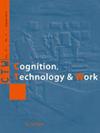Investigation of occupational fatigue and safety climate among nurses using the structural equation model.
IF 3.4
3区 工程技术
Q2 ENGINEERING, INDUSTRIAL
引用次数: 10
Abstract
BACKGROUND Nursing is associated with many stressful situations that can lead to fatigue, reduced efficiency, and physical and mental illness. Safety climate is one of the most important indicators of safety management performance assessment that assesses employees' attitudes towards safety issues. OBJECTIVE The purpose of this study was to investigate the relationship between safety climate and occupational fatigue in nurses. METHOD This descriptive-analytical study was performed on nurses working in hospitals affiliated to Zabol University of Medical Sciences in 2019. 143 nurses were selected by the proportional sampling method and entered the study. Demographic questionnaires, Occupational Fatigue Inventory (SOFI), and Nurses' Safety Assessment Questionnaire were used for data collection. Statistical tests, including Independent T-Test, ANOVA, Mann-Whitney U, Kruskal-Wallis, and multivariate analysis of variance (MANOVA) were used to analyze the results using SPSS software version 21, and the multivariate structural equation was used for modeling. RESULTS The mean scores of safety climate and occupational fatigue were 67.15±12.73 and 85.09±41.49, respectively. Job and demographic variables except for the second job (P-value = 0.065) had a significant effect on the variables of safety climate and occupational fatigue. There were also higher scores for occupational fatigue and all of its subscales in the group of women compared to the group of men. CONCLUSION The results showed that occupational and demographic variables have significant effects on safety climate and occupational fatigue. There was a significant relationship between demographic variables of age, work experience, and education level with safety climate. There was also a significant relationship between education level, job satisfaction, satisfaction with colleagues and work experience with occupational fatigue. Therefore, paying attention to fatigue and safety climate of nurses in workplaces is recommended.结构方程模型对护士职业疲劳与安全气氛的影响研究。
背景护理与许多紧张的情况有关,这些情况会导致疲劳、效率降低和身体和精神疾病。安全气候是安全管理绩效考核的重要指标之一,是对员工对安全问题态度的评价。目的探讨护士职业疲劳与安全气氛的关系。方法对2019年在扎波勒医科大学附属医院工作的护士进行描述性分析研究。采用比例抽样法抽取143名护士进入研究。采用人口统计问卷、职业疲劳量表(SOFI)和护士安全评估问卷进行数据收集。统计检验包括独立t检验、方差分析、Mann-Whitney U、Kruskal-Wallis和多变量方差分析(MANOVA),采用SPSS 21版软件对结果进行分析,并采用多变量结构方程进行建模。结果安全气候和职业疲劳平均得分分别为67.15±12.73和85.09±41.49。除第二职业外,职业和人口统计变量(p值= 0.065)对安全气候和职业疲劳变量有显著影响。与男性组相比,女性组在职业疲劳及其所有子量表上的得分也更高。结论职业和人口统计学变量对安全气候和职业疲劳有显著影响。年龄、工作经验、教育程度等人口统计变量与安全气候存在显著相关。受教育程度、工作满意度、同事满意度、工作经验对职业疲劳也有显著影响。因此,建议关注工作场所护士的疲劳和安全气候。
本文章由计算机程序翻译,如有差异,请以英文原文为准。
求助全文
约1分钟内获得全文
求助全文
来源期刊

Cognition Technology & Work
ENGINEERING, INDUSTRIAL-
CiteScore
6.90
自引率
7.70%
发文量
26
审稿时长
>12 weeks
期刊介绍:
Cognition, Technology & Work focuses on the practical issues of human interaction with technology within the context of work and, in particular, how human cognition affects, and is affected by, work and working conditions.
The aim is to publish research that normally resides on the borderline between people, technology, and organisations. Including how people use information technology, how experience and expertise develop through work, and how incidents and accidents are due to the interaction between individual, technical and organisational factors.
The target is thus the study of people at work from a cognitive systems engineering and socio-technical systems perspective.
The most relevant working contexts of interest to CTW are those where the impact of modern technologies on people at work is particularly important for the users involved as well as for the effects on the environment and plants. Modern society has come to depend on the safe and efficient functioning of a multitude of technological systems as diverse as industrial production, transportation, communication, supply of energy, information and materials, health and finance.
 求助内容:
求助内容: 应助结果提醒方式:
应助结果提醒方式:


